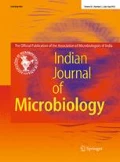Absract
OP phyla were created in the domain bacteria, based on the group of 16S rRNA gene sequences recovered from the Obsidian Pool. However, due to the lack of cultured representative it is referred to as candidate phyla. Wider ecological occurrence was predicted for the OP phyla, especially OP3, OP10 and OP11. Recently, members of phylum OP5 and OP10 were cultured, providing clues to their cultivation prospects. At last the bioprospecting potentials of the OP members are discussed herein.



References
Hugenholtz P, Pitulle C, Hershberger KL, Pace NR (1998) Novel division level bacterial diversity in a Yellowstone hot spring. J Bacteriol 180:366–376
Hugenholtz P, Goebel BM, Pace NR (1998) Impact of culture-independent studies on the emerging phylogenetic view of bacterial diversity. J Bacteriol 180:4765–4774
Ley RE, Harris JK, Wilcox J, Spear JR, Miller SR, Bebout BM, Maresca JA, Bryant DA, Sogin ML, Pace NR (2006) Unexpected diversity and complexity of the Guerrero Negro hypersaline microbial mat. Appl Environ Microbiol 72:3685–3695
Glöckner J, Kube M, Shrestha PM, Weber M, Glöckner FO, Reinhardt R, Liesack W (2010) Phylogenetic diversity and metagenomics of candidate division OP3. Environ Microbiol 12:1218–1229
Van Elsas JD, Torsvik V, Hartmann A, Øvreås L, Jansson JK (2007) The bacteria and archaea in soil. In: Van Elsas JD, Jansson JK, Trevors JT (eds) Modern soil microbiology, 2nd edn. Taylor and Francis, London, pp 84–102
Dedysh SN, Pankratov TA, Belova SE, Kulichevskaya IS, Liesack W (2006) Phylogenetic analysis and in situ identification of bacteria community composition in an acidic Sphagnum peat bog. Appl Environ Microbiol 72:2110–2117
Kuenen GJ (2008) Anammox bacteria: from discovery to application. Nat Rev Microbiol 6:320–326
Nichols D (2007) Cultivation gives context to the microbial ecologist. FEMS Microbiol Ecol 60:351–357
Mori K, Sunamura M, Yanagawa K, Ishibashi J, Miyoshi Y, Iino T, Suzuki K, Urabe T (2008) First cultivation and ecological investigation of a bacterium affiliated with the candidate phylum OP5 from hot springs. Appl Environ Microbiol 74:6223–6229
Rastogi G, Osman S, Kukkadapu R, Engelhard M, Vaishampayan PA, Andersen GL, Sani RK (2010) Microbial and mineralogical characterizations of soils collected from the deep biosphere of the former Homestake gold mine, South Dakota. Microb Ecol 60:539–550
Dojka MA, Hugenholtz P, Haack SK, Pace NR (1998) Microbial diversity in a hydrocarbon- and chlorinated-solvent contaminated aquifer undergoing intrinsic bioremediation. Appl Environ Microbiol 64:3869–3877
Harris JK, Kelley ST, Pace NR (2004) New perspective on uncultured bacterial phylogenetic division OP11. Appl Environ Microbiol 70:845–849
Stott MB, Saito JA, Crowe MA, Dunfield PF, Hou S, Nakasone E, Daughney CJ, Smirnova AV, Mountain BW, Takai K, Alam M (2008) Culture-independent characterization of a novel microbial community at a hydrothermal vent at Brothers volcano, Kermadec arc, New Zealand. J Geophys Res 113:B08S06
Tamaki H, Tanaka Y, Matsuzawa H, Muramatsu M, Meng XY, Hanada S, Mori K, Kamagata Y (2011) Armatimonas rosea gen. nov., sp. nov., a Gram-negative, aerobic, chemoheterotrophic bacterium of a novel bacterial phylum, Armatimonadetes phyl. nov., formally called the candidate phylum OP10. Int J Syst Evol Microbiol. doi:10.1099/ijs.0.025643-0
Pruesse E, Quast C, Knittel K, Fuchs BM, Ludwig W, Peplies J, Glöckner FO (2007) SILVA: a comprehensive online resource for quality checked and aligned ribosomal RNA sequence data compatible with ARB. Nucleic Acids Res 35:7188–7196
Portillo MC, Gonzalez JM (2009) Members of the Candidate Division OP10 are spread in a variety of environments. World J Microbiol Biotechnol 25:347–353
Schloss PD, Handelsman J (2004) Status of the microbial census. Microbiol Mol Biol Rev 68:686–691
Stott MB, Crowe MA, Mountain BW, Smirnova AV, Hou S, Alam M, Dunfield PF (2008) Isolation of novel bacteria, including a candidate division, from geothermal soils in New Zealand. Environ Microbiol 10:2030–2041
Mori K, Yamaguchi K, Sakiyama Y, Urabe T, Suzuki K (2009) Caldisericum exile gen. nov., sp. nov., an anaerobic, thermophilic, filamentous bacterium of a novel bacterial phylum, Caldiserica phyl. nov., originally called the candidate phylum OP5, and description of Caldisericaceae fam. nov., Caldisericales ord. nov. and Caldisericia classis nov. Int J Syst Evol Microbiol 59:2894–2898
Author information
Authors and Affiliations
Corresponding author
Rights and permissions
About this article
Cite this article
Rohini Kumar, M., Saravanan, V.S. Candidate OP Phyla: Importance, Ecology and Cultivation Prospects. Indian J Microbiol 50, 474–477 (2010). https://doi.org/10.1007/s12088-011-0144-z
Received:
Accepted:
Published:
Issue Date:
DOI: https://doi.org/10.1007/s12088-011-0144-z

